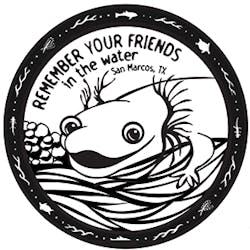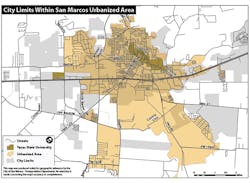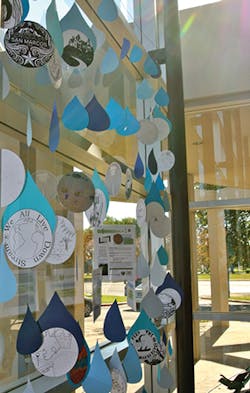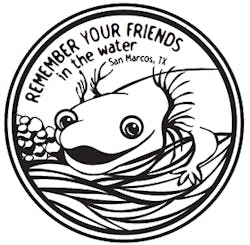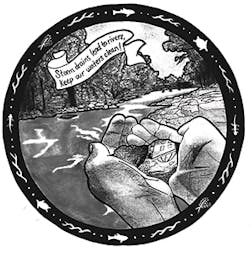MS4 Community Education, Outreach, and Involvement Through Art
This article presents the methods and results of an art contest held by the city of San Marcos and Texas State University from June through December 2013, one year prior to the issuance of two Phase II municipal separate storm sewer system (MS4) permits. Although the city and university applied for two separate permits, they agreed to share minimum control measure #1, public education, outreach, and involvement. Leadership in both entities understood the importance of working together on a shared community outreach program to provide a common message for protecting the unique San Marcos River watershed. The purpose of the art contest was to involve the community with a challenge: to create a unique design for the city’s and university’s storm drain covers that could be cast in steel and would show the connection of the drainage system to the river and creeks. The exercise of explaining this concept to the target audience, judges, and general community provided a broad opportunity for stormwater awareness and education. In all, 64 entries were received and five prizes were awarded. The final design was a combination of art by two artists and was chosen by both the city and university. It became a campus and city standard for all new covers for development throughout the city and campus. The first covers were placed on new city drains in July 2014 and later at Texas State University in March 2015. The contest was a jumpstart to the city’s and university’s stormwater awareness programs and was successful at uniting the two communities for a common cause of care for the river.
Introduction
San Marcos, TX, is located in south central Texas between Austin and San Antonio along the IH-35 corridor. The city was designated by the US Census Bureau in 2013 and 2014 as the fastest-growing midsize city with a population over 50,000 in the United States due to the rapid growth shown over the past years. The city was also classified as the only new urbanized area in Texas in 2010 (Figure 1), and with this designation San Marcos became regulated under the Texas Pollutant Discharge Elimination System (TPDES) stormwater regulations. Midsize and small municipalities in urbanized areas are regulated under the Texas Commission on Environmental Quality (TCEQ) Phase II MS4 general permit.
Texas State University is located within the city’s urbanized area (Figure 1) and also became subject to the Phase II MS4 general permit along with San Marcos. Both the city of San Marcos (CoSM) and Texas State are unique urbanized areas because they are located in a sensitive area, the upper San Marcos River watershed. The San Marcos River is a spring-fed river and is home to five species protected by the Endangered Species Act: the Texas blind salamander, the San Marcos salamander, the fountain darter, the San Marcos gambusia, and Texas wild rice. The river is also classified for recreational water use and as a drinking water source by the TCEQ. Because of its crystal clear, constantly flowing waters, it is a major tourist and resident attraction for both entities.
For all of these reasons, it is critically important to protect the water quality and the river itself from the effects of urbanization and pollution. In a joint effort, the CoSM and Texas State agreed to share minimum control measure one (MCM-1) of the MS4 permit, which covers public education, outreach, and involvement. The intent of this shared MCM is to spread a unified message to the city’s residents and the university’s students, through educational efforts and volunteer opportunities that provide protection to the river and its tributaries. These opportunities are meant to raise the public’s awareness of the potential threat to water quality in the upper San Marcos River watershed while promoting pollution prevention and common sense techniques that everyone can do to protect the river.
We chose as our first joint project an art competition to design a new storm drain manhole cover, to be cast in steel, which will be installed on all new construction projects and retrofit projects. The intent of the new cover is to draw attention to the storm drain system and remind citizens of the direct connection that the storm drain system has to the river, in the same way that an inlet marker or stencil would. The final storm drain manhole cover design has been well received by the university and the residents of San Marcos.
The competition was developed by the Public Services Department, Transportation Division, within the CoSM and by the Environmental Health Safety and Risk Management (EHSRM) office at Texas State.
Methods
Getting Started. The idea for this project came about during joint meetings between the CoSM and Texas State concerning the MS4 permit. Once the idea had taken root and each entity agreed to move forward with it, we contacted TCEQ for approval. We wanted the blessing of TCEQ because neither entity was officially designated as an MS4, but we each wanted to receive credit for the contest in our stormwater management program. After receiving approval, the next step was to investigate what projects of this nature had been done within the CoSM and among other communities. We found that art competitions had been used by the CoSM for water conservation education and outreach, sustainability, and green living, among others. The CoSM water conservation coordinator led us through a process for art contests that included promotion, collecting the artwork, judging the entries, and selecting and recognizing the winners. We found no examples, however, where the city and university had conducted joint projects of this nature. We also found few examples of using art competitions to promote stormwater awareness.
The most relevant contest we found for stormwater awareness was done by the city of Springfield, MO, in 2007 when it held an art contest to design a new storm drain manhole cover. The city’s objective was to draw attention, through art, to the fact that stormwater drains from streets and lawns to rivers and creeks, untreated. That art contest served as a good model for our project, and the staff at the Springfield Public Works Department provided useful guidelines and assistance to us during the process.
Advertising and Promoting. To begin the art contest, we developed a flier that we hoped would be eye catching and contain information that would encourage the community to participate in this project. The flier for the art contest became the first method of stormwater education and outreach that we had ever developed as an educational tool to be distributed communitywide. It provided a stormwater message about the effects of runoff to the river and creeks, as well as basic information about who could enter, the deadline for submittal, and where to submit the entries. We received and incorporated comments from the San Marcos Arts Commission and the Texas State Art and Design department to clarify the content and information conveyed with the flier.
The competition was open to anyone who lived, worked, or attended school in San Marcos, including Texas State students. Those eligible were divided into different age groups: 10 and under, 11 to 13, 14 to 18, and over 18, with a monetary prize for the winner of each category.
We kicked off the competition in early September 2013 by providing a press release and the flier to our community relations departments to distribute through local newspapers and social media outlets. The city and university community relations departments worked well together to promote the contest and were valuable assets for promoting participation and drawing attention to water-quality issues and runoff.
The kickoff date coincided with the early months of the fall semester for public schools and university students. The community was given until November 1 to submit entries to the CoSM Public Services Department’s Transportation Division. This timing was based on guidance we received from art teachers in the public schools and the university’s art department for optimal student participation. We submitted informative letters to the public, private, and homeschool art teachers describing in more detail the intent of the art competition and requirements and containing links to stormwater awareness curricula. We were amazed by the different means of advertising the contest, which included:
- Press releases to the local newspaper and university paper
- Radio interviews with the contest organizers on the university radio station
- Posts to the city and university websites and Facebook and Twitter pages
- Use of the university intranet to instantaneously announce the contest to approximately 40,000 employees and students on campus
- Intranet press release to approximately 500 CoSM staff
- San Marcos Consolidated Independent School District Web postings and Intranet
- Posting of the fliers in many local businesses, coffee shops, public places, university bulletin boards, K-12 schools, churches, etc.
Each method of promotion included the message of stormwater awareness and why we were trying to draw attention to and differentiate the storm drain covers from other utility covers (telecom, sanitary sewer, steam, etc.) and why this difference is so important to the environment. The art contest was a fun and friendly method of bringing this topic into everyday conversation and classroom discussions.
Receiving the Entries. During the six-week contest period, both the CoSM and Texas State stayed in contact with the art teachers, professors, and Arts Commission who had links to local artists, to ensure that progress was being made and the interest remained. To have a successful outcome, we needed a number of entries. Additional press releases were sent to all media outlets as a reminder of contest deadlines. As the deadline neared, the entries started arriving at the Public Services’ office.
Each entry was assigned a unique number and logged into a file that kept track of the name, address, and age of the artist. In all, 64 entries were received. The entries were divided into the age groups designated by the contest rules, copied, attached to a scoring sheet, and placed in three-ring binders (eight identical binders for eight judges). This step took more time than anticipated as some of the work did not copy well and adjustments were made to represent each piece as clearly as possible. The time between receiving the entries and submitting the binders to the judges was only one week, so efficiency and teamwork between Texas State and the CoSM was critical.
Activity Center, November 2013
Also during this time, each entry was scanned to an electronic file and posted on the CoSM and Texas State websites. A public display of the entries was hung in the San Marcos Activity Center for several weeks. The display consisted of each 6-inch manhole cover art mounted to a blue, gray, or green raindrop shape and hung by clear line from an elevated beam. The effect was as if manhole covers were raining down out of the sky with artwork depicting the river, runoff, and the connection between the two. Informational signage about the art competition was hung among the raindrops (Figure 2) and formed another means of providing education and outreach on stormwater awareness to the general public. The raindrop display appeared as a press release in the local newspaper.
Judging and Selecting. Eight judges were selected to represent the city, county, public, and university interests. The selection of the judges was a collaborative effort among the CoSM and Texas State, who sought parties that had an interest in the outcome of the project, understanding of the intent of the project, and an eye for art. Judges were sent a letter from the CoSM describing the requirements for scoring the entries. The letter also provided a description of stormwater and its effects on the river from urbanized areas. This letter and judging exercise allowed for thoughtful ownership of the stormwater program objectives and possible buy-in to the protection message by those considered influential. The judges included top city directors, elected city and county officials, university directors of marketing, and local art-minded business owners.
The four criteria for scoring the artwork were
- Originality of the artwork
- Uniqueness to San Marcos
- Content showing a water-quality message of how protecting our local waters begins at the storm drain
- Overall appearance, pleasing to the eye
Each criterion was valued from 0 to 25 points, with a perfect score of 100. As the judges returned their graded notebooks, the scores were entered into a spreadsheet by the event organizers, and the averages of the eight judges’ scores were calculated and sorted by age group. The numerical scoring process was a method to reduce the 64 entries to a manageable number of four semifinalists within each age group.
This step also was challenging because the time to receive and summarize the judges’ notebooks, in preparation for phase two of judging, was only a matter of days. Once again teamwork among the city and university event organizers was critical.
The second step of the judging process was a collaborative open discussion of the artwork among the eight judges. For this step, a representative from EJ USA, the foundry that would eventually cast the winning design, was present to evaluate the art in terms of its suitability for casting to steel covers. The semifinalists for each age category were displayed in a PowerPoint slide show and openly discussed by the judges using the criteria stated above. The discussions were lively and enjoyable, and the room was filled with their comments and observations, each viewed through different life experiences. At the end of the discussion a blind vote was taken and the winner, based on majority vote, was announced and posted on a separate board.
This process was repeated for each of the age categories. In some cases the votes tied and the discussions would reopen and repeat. By the end of about an hour, five finalists remained. The final selection had the judges going back and forth until one design floated to the top. It was coupled with a second design that was very well liked, but not entirely capable of being cast into steel (Figures 3 and 4).
The end result was a combination of the two designs to form a composite design approved by all judges. The winning designs were a San Marcos River salamander with a friendly water-quality message, “Remember your friends in the water,” surrounded by an outer rim of river animals. Figure 5 shows the combined designs.
Awards and Post-Event Activities. Within one day following the judging in December, the winning artists were contacted by phone with the news. The winners in the K-12 schools were given “big” checks at their schools and photographed with the event coordinators. At the junior high school, the band and choir performed for the event. All of the winners in the four categories were again awarded the “big” checks in the CoSM Council chambers, and multiple press releases were published in the local newspaper. The CoSM brought the winners back to council chambers for a city proclamation in late January to proclaim that January 21, 2014, was Art and the Environment Day.
winning design
The three winners in the 14 to 18 and over-18 categories were all Texas State students. The Texas State Department of Engineering Technology gave the students a tour of its foundry and demonstrated the casting process by pouring 6-inch bronze medallions of the cover design. The students were awarded the polished medallions in a ceremony that was published in the Texas State quarterly magazine for alumni, called Hillviews.
All 64 entrants were mailed a certificate of appreciation signed by the director of the EHSRM department and director of the Public Services Department, and the eight judges were mailed thank you letters. With each of these methods of recognition and appreciation, the importance of the created designs was tied back to the message of protecting the water quality of the river by limiting pollutants that enter it through the storm drain system.
The first storm drain cover for the CoSM was installed in July 2014 and the first for Texas State in March 2015. Of course, both events were published in the local newspaper and on the CoSM and Texas State websites with an environmental message.
Lessons Learned
Upon completion of the project, we were able to look back and reflect on the art contest and think of what went right and what could be improved on. We wanted to improve the process for ourselves and others wanting to host a contest for stormwater awareness. The following are lessons learned from our art contest.
What went well:
- We got to know our audience by talking with art teachers, professors, school district public relations staff, and Arts Commission board members to learn the best timing for maximum student participation and community interest during a busy school year. We learned to start right after Labor Day and finish before the winter break in December.
- We maximized the education and outreach effect of the art contest by having many press releases, radio interviews, and social media postings utilizing the resources and media of both the city and university.
- We had eight judges who provided a diversity of experience and knowledge.
- We had a formal city proclamation with top managers including the mayor, city manager, and division and department managers in honor of the winning artists for each age group. The artists and city and university officials were able to state the significance of the art contest in relation to protection of the river, and this meeting was televised to the San Marcos community.
- We reached a broad audience, including the influential people stated above, by centering stormwater education on a fun art project.
Room for improvement:
- Develop a general stormwater awareness presentation to give to the art classes in K-12 schools to provide more background information to the students.
- Involve other departments within the city and university to provide more resources and skills and to distribute the tasks.
- Hire or use a staff graphic designer to develop the flier.
- Preplan the contest from beginning to end prior to launching: Create templates for the judging spreadsheet, tally sheets, and certificates of accomplishment; copy art entries for the judges’ notebooks as they arrive; and write basic press releases and proclamation notices, leaving blanks to add in detail.
- Partner graphic art students at Texas State with any K-12 students wanting assistance to take the younger person’s concept art idea to a graphic design level to “even out the playing field.”
- Ask for more involvement from the commercial foundry’s art department and products staff to provide clarifications on the qualities of the design to be cast-ready and provide examples of existing artistic storm drain covers conveying a stormwater protection message.
- Have a larger ceremony for the winning artists to include a broader audience.
- Have patience: The time between the selecting the winners and the arrival of the covers for installation can take up to six months.
Conclusions
In summary, this contest was very successful and was well received by the San Marcos community. It can serve as a model for other communities to use if they choose this method of outreach. Communities that would like to hold a similar contest can expect good results if they follow a few basic guidelines:
- Know your audience. You can’t expect to have good results if you can’t reach the intended audience. A large portion of our audience was students. For us, this meant timing was important for public school and university participation.
- Preplan. Preplan as much of the event as you possibly can. The more you plan in the beginning, the less burdened you will feel towards the end of the event.
- Partner and collaborate. Work with as many city departments, university departments, civic groups, commissions, school districts, etc. as you can. This collaborative process not only spreads your message, but with buy-in, you will develop a team of people who want to see a successful outcome and will work hard to achieve it.
- Maximize your opportunities. Opportunities for education exist everywhere. Be creative and use everything available to you to spread your message. This may include older forms of communication such as posters and press releases, or newer methods like Facebook and Twitter. Remember, “Know your audience.” If you can’t reach them, you can’t educate them.
- Include experts. Don’t be afraid to use an expert. Not only will the final result of your project be better, but you will have a lot fewer headaches.
- Have fun. A project as big as this can be overwhelming. Remember to have fun with it.
Acknowledgements
The authors thank the following people and companies for their assistance on this project. Without their guidance, experience, and insight, the project would have been much more difficult.
- Jan Klein, water conservation coordinator, city of San Marcos, gave us the basic structure for the art contest based on her successful experiences with similar contests.
- Carrie Lamb, water quality coordinator, city of Springfield, guided rollout and judging steps and provided overall support of our effort.
- EJ USA sales representatives Russell Durst and Dan Weidner promoted the idea of unique artwork on storm drain covers.
- EJ USA distribution center manager David Plesher, with the Ardmore, OK, foundry arranged a tour of the process and showed many examples of designs on steel covers.
- Colleen Cook, stormwater specialist for EHSRM, Texas State University, carried out the labor-intensive tasks of the contest including copying; binding; entering data; and creating tally sheets, certificates of appreciation, raindrop public display, “big” checks, and other award-related props.
